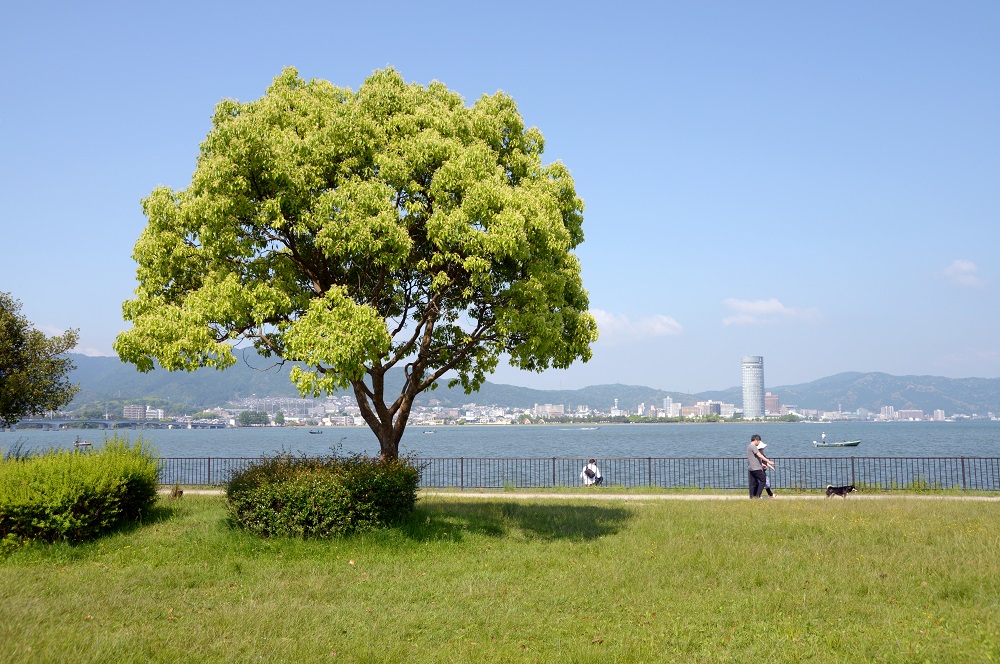Biwako [Lake Biwa] / 琵琶湖 (Shiga)
About Biwako [Lake Biwa]
Biwako [Lake Biwa], located in the center of Shiga Prefecture, is the largest freshwater lake in Japan occupying about one-sixth of the land area of the prefecture. Surrounded by lush green mountains and rural scenery to immerse with the water and lush nature. Lake Biwa is said to have four million years of history and is one of the 20 ancient lakes in the world. As the home of over 1,700 species of aquatic plants and creatures, including over 60 endemic species, Lake Biwa is an invaluable natural environment. The lake is also a critical source of water used for daily life and industry not only by residents of Shiga Prefecture, but also by many people living in Osaka, Kyoto, and other parts of the Kansai Region. The tranquil scenery comprised of the lake and the environments let visitors enjoy every moment of each brilliant season.

Biwako [Lake Biwa], the largest lake in Japan, has an area of approximately 670k㎡ and shoreline extending around 235km, maximum depth approximately 104m, and a water storage capacity of 27.5 billion ㎡. Fault activities caused a shallow and narrow lake formed near Iga City, Mie Prefecture called Lake Oyamada to gradually changed shapes and moved up north and became Biwako [Lake Biwa]. While lakes usually tend to disappear in about 10,000 years due to sedimentation, Biwako [Lake Biwa] has been maintained in current position for about 400,000 years, although being constantly moved for a long period of time. Being only one in Japan of the 20 ancient lakes in the world, and existing for more than four million years makes a global value for Biwako [Lake Biwa].

Down through the ages, some organisms have evolved in their own unique ways, giving rise to many endemic species unique to Biwako [Lake Biwa]. Currently, Biwako [Lake Biwa] is home to more than 1,700 species of aquatic plants, of which more than 60 are endemic, including early endemics such as the "Biwa-Higai" [Sarcocheilichthys variegatus microoculus] and "Sugomoroko" [Squalidus chankaensis biwae], a minnow, as well as relict endemics such as the Biwako giant catfish [Silurus biwaensis] and "Gengorobuna" [Japanese crucian carp]. At the Lake Biwa Museum in Kusatsu City, families enjoy learning about the origins of Biwako [Lake Biwa] and the relationship between people and the inhabitants of the lake.

Especially on weekends and holidays, many visitors from nearby areas gather to Biwako [Lake Biwa] and enjoy camping, BBQ, and other recreational activities. Lake sports, like yachting and canoing, beaches for swimming and marinas are popular and attract about 700,0000 people each year. Biwako [Lake Biwa] is about 235 Km in circumference and is able to be traveled around by bicycle in two days, and the act of cycling or walking around the lake is known as "Biwaichi" (One lap around Biwako [Lake Biwa]). A trip around Biwako [Lake Biwa] is bound for a sense of the size of the lake.
Getting there and around
by Train
■From Tokyo and Nagoya
Take the JR Tokaido Shinkansen to JR Kyoto Station, transfer to the JR Biwako Line, disembark at Otsu Station.
Duration: From Tokyo-approx. 2 hours 30 min., From Nagoya-approx. 50 min.
The area surrounding Biwako [Lake Biwa] is accessed by the JR Kosei Line, JR Tokaido Main Line, and JR Hokuriku Main Line.
Recommendations
Lake Biwa Museum / 滋賀県立琵琶湖博物館
Learn about the history of Biwako [Lake Biwa], at the Lake Biwa Museum of Shiga Prefecture, along with the people that inhabit its surroundings, and see the creatures that live in the lake. The Aquarium exhibition room with area of approximately 2,000㎡, makes it one of the largest freshwater creature exhibits in Japan. Visitors are able use all the five senses to experience the nature, creatures, and lifestyle that thrive around Biwako [Lake Biwa].

Avenue of Metasequoias / メタセコイア並木
Approximately 500 Metasequoia [Dawn Redwood] trees are planted along a 2.4 Km stretch, creating a picturesque sight perfectly complementing the mountains in the distant background, leading to the Makino Kogen [plateau]. In spring, the leaves of the Metasequoia [Dawn Redwood] are in a brilliant green color, growing deeper in summer, finally turning bright red in the fall. Even after losing leaves in winter, the Avenue of Metasequoia has an enchanting vista of snow-covered trees, attracting visitors regardless of the season.

Omimaiko Beach / 近江舞子水泳場
The pristine oasis is characterized by a 4 Km-long white sandy beach and crystal-clear water. Unlike saltwater, swimming in this peaceful freshwater place does not make your body feel sticky afterward, making Omi-Maiko Beach a popular spot for families. Particularly in the summertime, this beach gets lively with people enjoying windsurfing and swimming.

Biwako Valley / The Biwako Terrace / びわ湖バレイ・びわ湖テラス
Biwako Valley is a resort located 1,100 meters above sea the level overlooking Biwako [Lake Biwa], with an abundance of restaurants, stores and activities, along with The Biwako Terrace, a place to relax and enjoy the spectacular scale and power of Lake Biwa. Turning into a ski resort on the outskirts of Otsu City in winter, a variety of fields are enjoyed by beginners and experts alike, and cherry trees blossom in the springtime, as well as beautiful autumn foliage in the fall are also enjoyed.

Travel Recommendations
Chikubushima [Chikubushima Island] is a small island, with a circumference of around 2 Km, floating in Biwako [Lake Biwa]. The island has long been worshiped as a sacred place where the "Kami" [deity] reside, and in recent years, has become one of the most popular power spots in Biwako [Lake Biwa]. Despite the size of the island, it is fully packed with sightseeing spots, with buildings designated as National Treasures and Important Cultural assets. Nagahama City, where boats depart for Chikubushima [Chikubushima Island], is able to be reached in a little over an hour by train from Nagoya, so a visit to Chikubushima [Chikubushimashima Island] is highly recommended!
